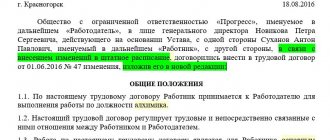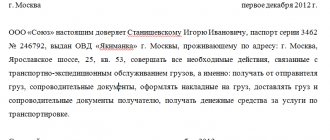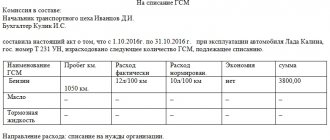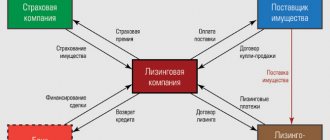The formation of specifications for the supply of goods occurs only after the conclusion of a supply agreement. The document is not independent, but serves as an annex to the agreement, being an integral part of it. Specifications are quite widespread (especially in trading companies), even though they are not mandatory.
- Form and sample
- Free download
- Online viewing
- Expert tested
FILES
Why do you need a specification?
Any contract, including a supply contract, includes a number of certain data:
- the name of the entities between which it is concluded;
- the object of the contract (i.e. the supply of specific goods or materials is indicated);
- price;
- the conditions under which it must be fulfilled;
- rights, obligations and responsibilities of the parties for its violation.
As a rule, contracts are standard and they do not always specify specific product names, which is most often due to the fact that its volume can be quite impressive. And here a special annex to the contract comes to the rescue - the specification.
The specification is also drawn up in writing and gives a complete picture of the list of goods or materials, their unit of measurement, quantity, grade, type, purpose, as well as other characteristics and features.
The specification is most relevant when it comes to a long-term contract, on the basis of which inventory items will be delivered from the supplier to the consumer more than once.
What is a specification and why is it needed?
In dictionaries, a specification is defined as a tabular document indicating the composition of a product.
In relation to agreements for the supply of goods, it characterizes and describes in detail each instance of the shipped product.
The purpose of this form is to identify each product name by type, assortment, grade and other features, indicating the full price, its components, delivery time and place.
It is the specification that is the main confirmation of the supplier’s agreement to deliver and the buyer to accept each specific product at a set price and other conditions. When disputes and proceedings arise in the courts, it often becomes the decisive factor in whether the plaintiff or defendant confirms their position.
For example, the supplier shipped the ordered products with a delay of two days and the presence of mismatches, the buyer refused to accept it. The problem that arose was discussed at the meeting by the managers and lawyers of the shipper and consignee. Having carefully studied the specifications for the supply agreement, the parties were convinced that the buyer was completely right and strictly adhered to its terms during subsequent shipments of goods.
How to draw up a specification, sample
Today there is no unified specification form, so employees of organizations and enterprises can draw it up in any form or, if the company has a developed and approved document template, based on its sample. The main thing is to meet only two basic conditions: in its structure it must meet certain standards of office work, and in content it must include a number of certain data.
to header :
- number and date of conclusion of the agreement to which it is annexed;
- specification number, as annex;
- indicate the title of the document.
The second part of the form is the main one. It almost always looks like a table, which includes the following information:
- name of goods or materials;
- their unit of measurement;
- quantity;
- price for one;
- total cost.
If necessary, the table can be supplemented with other additional data.
Then, under the table, it would be a good idea to enter the terms of payment for products according to this specification (they may correspond to the terms of the contract, or they may be changed, depending on the circumstances).
How to fill out
There are no requirements for drafting in contract legislation. If you are developing this document yourself, be sure to indicate the following fields to fill out:
- Number in order.
- Name of the product, work or service.
- Technical characteristics.
- Quantity of goods or volume of services (work).
- Unit of measurement.
- Cost of each item.
- Total cost for each item. It is formed by multiplying the quantity by the price of this item.
- Total.
Provide an execution schedule as additional information. This document, like a contract, is signed by the parties to the transaction and drawn up in the same number of copies as the contract.
What to pay attention to when preparing a specification
The specification can be drawn up on the organization’s letterhead or on a simple blank sheet of paper of any convenient format, either in handwritten form or by printing it on a computer.
Only one condition must be strictly observed: the form must contain the signature of the head of the supplier company or his responsible representative, as well as the signature of an employee of the organization - the consumer.
At the same time, their autographs should only be “live” - the use of facsimile signatures, i.e. printed by any method is not permitted, except in situations where the contract is concluded remotely, and enterprises have officially registered electronic digital signatures.
There is currently no strict need to certify the specification using stamps - it needs to be stamped only if the use of stamped products is prescribed in the regulatory legal acts of organizations.
The specification is drawn up in two copies identical in text and equivalent in law - one for each interested party. After formation and endorsement, information about the document is entered into a special log of contracts.
Specification for the contract: when is it needed and how to draw it up
The terms of the contract can be stated in different ways. For example, by reflecting them directly in the text of the agreement or in additions to it. Alternatively, in the specification. Let's figure out what kind of document this is and how to draw it up. An example would be a supply agreement.
Why do you need a specification?
In order for a supply agreement to be considered concluded, the parties must agree on the name and quantity of the goods to be sold <*>. The option when this is done directly in the contract is not always suitable. In particular, this method could be:
- inconvenient. For example, if the parties fix a list consisting of hundreds of items of goods with different units of measurement and characteristics (color, size, etc.) in the text, this will overload the contract and make it difficult to understand its terms;
- not applicable. For example, for a framework agreement, i.e. an agreement in which the parties stipulate the basic conditions (general name of the goods to be sold, the period of validity of the framework agreement, the procedure for resolving disputes, etc.) and at the same time agree that the specific name and quantity of the supplied goods are agreed upon separately for each transaction.
A special document signed by the parties and attached to the main agreement as its integral part - a specification - will help you get out of the situation.
The specification, as a rule, agrees on the subject of the supply contract, i.e.:
- name and describe the goods to be sold;
— indicate the quantity of goods for each product item.
Note Usually, the specifications indicate goods supplied in one batch, i.e. simultaneously. For the next delivery, a new specification is signed.
Often, a specification is also considered as a document that allows, in addition to the name and quantity of a product, to establish its price, delivery time, payment, etc. This is usually done in cases where, during long-term cooperation, it is not economically feasible to strictly fix conditions, for example, price, for a long period of time.
The fact that these conditions will be defined in the specification must be recorded directly in the contract <*>.
Example of wording The supplier undertakes to deliver, and the buyer – to accept and pay for the goods. The name, quantity and price of the goods to be transferred to the buyer within each specific batch are determined in accordance with the specifications for each batch of goods, which are an integral part of the contract.
Recommendations
1. Having secured such wording in the contract, it is imperative to agree on the mentioned conditions in the specification. Otherwise, the contract will be considered not concluded <*>. This means that the parties will not be able to demand fulfillment of obligations and apply liability for their failure to fulfill them.
2. The terms of the contract and the specifications for it must not contradict each other. Otherwise, when a dispute arises, the court will find out the common will of the parties, evaluate negotiations, correspondence and their subsequent behavior <*>. And without determining what the parties had in mind, it may recognize the terms as inconsistent with the ensuing consequences. For example, if it is:
- on the name and quantity of the goods - the contract will be considered unconcluded;
- delivery time - the supplier will be obliged to deliver the goods within a reasonable time. If this does not happen - within seven days from the date of receipt of a written request from the buyer for the delivery of goods <*>.
Alternatively, the contract can indicate which has priority: the contract or the specification. Or eliminate inaccuracies by additional agreement <*>.
Note: The Specification is not the only document that specifies the terms of the contract. For these purposes, you can use, for example, price approval protocols, additional agreements, invoices, etc.
How to draw up specifications for a contract
What the specification should be is not defined by law. Therefore, it can be compiled in any form. If the parties first develop a specification form and fix it in the contract, they will need to use this template when preparing the specification.
In any case, the specification should be drawn up in writing <*>. Usually one document is drawn up in two copies - one for each party to the contract.
Typically, the specification contains:
1) details:
- date and place of compilation.
Note! The specification must be signed during the contract period. Otherwise, the parties will not be able to demand fulfillment of obligations by referring to it. That is, they will not be able to apply the conditions fixed there regarding liability, delivery times, payment, etc. In this case, the signed specification containing the essential terms of the supply contract will act as an independent contract;
— number — if there are several specifications;
— details of the agreement to which it was drawn up;
2) preamble:
— names of the parties to the agreement;
- FULL NAME. persons authorized to sign the specification, their positions, as well as the name of the document from which such authority arises. For example, charter, power of attorney.
Sometimes this information is omitted. We believe that this is acceptable in situations where the contract and specification are signed by the same persons. If authorized employees change, it is better to indicate this information. In controversial cases, this will facilitate verification of the powers of the counterparty’s representative;
3) content:
— list of supplied goods.
It is recommended to describe each item of the product in as much detail as possible. As a rule, under a supply contract, things that have generic characteristics are sold. In order to specify the product, i.e. to determine a variety, you can indicate in the specification, along with the general name, its specific category, type, brand, model, article number, grade, class, physical properties, etc.
Note: To determine the necessary characteristics of a product, you can use: - Legal regulations (TNLA) that describe the product, containing its general characteristics and requirements for it. For example, technical regulations of the EAEU, GOSTs, standards and technical conditions of organizations; documents related to the product. These include a technical passport, a quality certificate, and an instruction manual.
This will allow the supplier to avoid claims upon acceptance, and the buyer to purchase the product he is interested in.
In some cases, the parties agree to supply goods in an assortment. That is, goods of the same name, but with different characteristics (size range, color, etc.). In this case, the assortment conditions also need to be agreed upon <*>. If other conditions relating to the item of delivery are agreed upon in the specification, it is logical to fix the assortment there.
If the assortment is not agreed upon, the supplier will be able to supply the goods in the assortment that he himself determines, taking into account the buyer’s needs known to him, or refuse to fulfill the contract altogether <*>;
- quantity of goods . It is usually indicated in the appropriate units of measurement. For example, for bulk goods these are kilograms.
Legislation allows you to agree on the quantity of goods in monetary terms <*>. In this case, the specification indicates the total cost of the product and the price per unit. The quantity is determined by dividing the first value by the second. But this method is used less often;
- price of the product. Most often, the parties agree on a price per unit (piece, meter, etc.) of the product. It is recommended to make a note about whether VAT is included in the price. For example, by indicating “unit price (with VAT of 20%)” or by highlighting VAT separately. Otherwise, the amount of tax may be presented for payment in excess of the stipulated price of the goods <*>.
If the supplier is exempt from calculating and paying VAT or applies a special tax regime without calculating and paying such tax, it is worth making the note “Unit price (excluding VAT)”.
If necessary, the specification can include:
a) the total amount of all goods of one item. It is calculated by multiplying the price per unit of a product by its quantity;
b) the cost of all goods specified in the specification;
- other conditions - if it is necessary to specify the delivery according to a specific specification. These may be conditions for containers and packaging that are different from those agreed upon in the contract, the method and time of delivery, payment, etc.
The content can be presented in the form of a table. This is especially convenient when there are many product positions.
Example of table header design
| N p/p | Name and range of products | Unit | Quantity | Unit price, including VAT (20%), RUR. cop. | Total price, including VAT (20%), rub. cop. |
4) signatures of representatives of the parties. Since the specification contains the terms of the contract, the parties must confirm that agreement has been reached on them. To do this, authorized representatives, as a rule, affix a signature and its transcript, and also indicate their positions <*>.
Note: The specification is stamped only when it is provided for in the contract <*>.
If necessary, in this part of the specification you can duplicate the addresses, telephone numbers of counterparties, and their bank details. This is relevant if the parties cooperate on a long-term basis and the specified details change over time.
Read this material in ilex *follow the link you will be taken to the paid content of the ilex service










